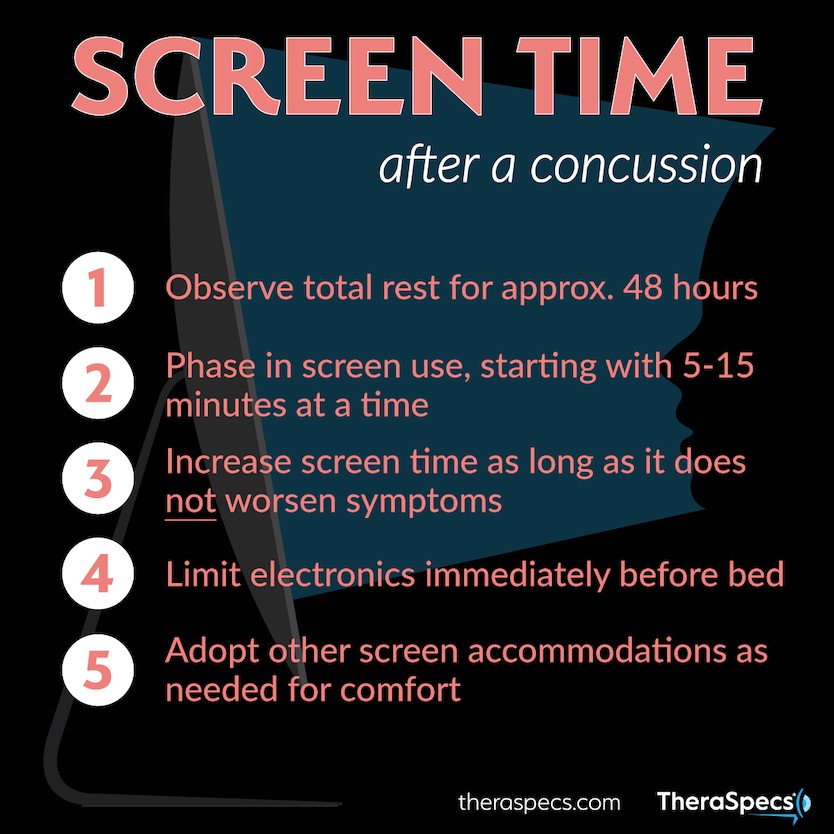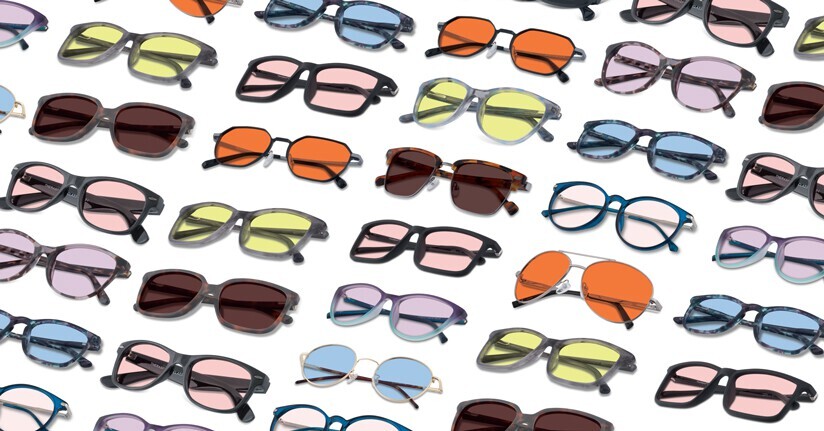Screen Time after a Concussion: Should You Limit Use of Electronics?
As the medical community learns more about the short- and long-term impact of concussions on the human body, doctors and experts on brain injuries are able to provide more precise guidelines for concussed individuals looking to return to normal activities.
Screen time after a concussion has been a particular source of debate over the years, with longstanding recommendations suggesting that people completely avoid all use of electronics during the acute phase of recovery and as their symptoms fully resolve. However, the issue of screen exposure has become much more complicated recently as new research emerges.

Recommendations for screen use after a concussion
Experts have clearly stated in recent years that there is no benefit to limiting—or more accurately, eliminating—screen time during the earliest stages of recovery after a concussion. However, the exact prescription for how and when to use your devices contains important nuances of which patients need to be aware.
As a result, we compiled guidance from leading authorities on concussion, such as the CDC, the American Academy of Pediatrics and leading headache specialists and neurologists, to bring forth the most comprehensive and up-to-date recommendations for screen time after a brain injury.1-3 *Please note these are not a substitute for medical advice, as you should always consult your physician to develop a specific concussion recovery plan.
Here are the latest recommendations:
- A period of total rest should be observed immediately following the concussion, generally not longer than 48 hours
- Gradual phasing in of screen time can follow, starting with 5-15 minutes at a time
- Patients can maintain or increase electronics use as long as it does not worsen symptoms
- Screen and blue light exposure should be limited at night in the hours before bedtime so as to not interfere with sleep cycles
- Additional screen-related accommodations should be considered and adopted as appropriate (described in more detail below)
It is important to realize that each person responds differently to a brain injury, regardless of severity; some may need more than 48 hours of cognitive and physical inactivity, and others may have higher or lower tolerance levels for screen light. In addition, these recommendations are not intended to distinguish between types of concussions (for example, a sport-related injury), which may further require adaptation for the unique variables of the injury. Ultimately, these are simply guidelines for post-concussion screen use, not hard-and-fast rules.
Why screen time should be gradual, not eliminated, during recovery
For years, experts believed that extended rest in the days immediately following a concussion was the most appropriate course of action. This meant limited engagement in cognitive activities (such as work or school), reduced or negligible physical activity and avoidance of screens and anything else that might worsen symptoms. This advice stemmed largely from the fact that the risk for poor recovery outcomes (including follow-on injuries) potentially increased with the introduction of strenuous activity too soon in the process.
In addition, many who endure these mild traumatic brain injuries have symptoms that go beyond just a few hours, with some even developing post-concussion symptoms that last for several weeks or months. In an ideal world, all symptoms would resolve themselves before fully immersing oneself back into the daily routine—and it would also help reduce some of those risks described above. Out of an abundance of caution, doctors and specialists repeated this recommendation over and over; in fact, leading headache specialist Dr. Amaal Starling told Neurology Today back in 2018 that 90% of the patients she sees had been prescribed this “cocooning” or total rest therapy.4
However, that has changed in recent years with the publishing of new research. It started with emerging evidence that physical and mental exertion earlier in the recovery phase, even in limited amounts, did not hinder long-term prognosis.5,6 In particular, there was no added benefit for having an extended rest period beyond 48 hours, and moderate activity may in fact improve outcomes for patients.
Furthermore, clinical research has indicated that complete removal of electronics—along with other cocooning activities like constantly wearing sunglasses indoors or staying in a dark room—may contribute to social isolation, depression and/or anxiety.7 The inability to stay connected to work or school through our devices can further compound feelings of stress and other negative outcomes as well. And countless studies have cautioned against extended time without stimulation (such as staying in a darkened room) for other conditions too, notably migraine and headache disorders. Read more about the emotional consequences of light sensitivity here
This is why experts are encouraging concussed patients to incorporate normal activities, such as using the computer or viewing a smartphone screen, for as long as they can tolerate it. If exposure to screen light or motion exacerbates headache pain, dizziness or other symptoms, then it should be scaled back. Otherwise, you can continue to push toward normal levels of use each day.
Other accommodations for safe use of electronics after concussion

Even with these suggestions, certain complications can still exist. On the one hand, bright, artificial light can affect post-concussion headaches, migraines and other neurological symptoms, particularly LED and LCD screens.8 Yet, clearly total avoidance of devices is not appropriate either. So how can people who experience a concussion use their screens safely in the days and weeks following the injury? There are numerous accommodations that can help relax your eyes and ease the strain on your brain. For example:
- Enable screen-related apps and features, which reduce brightness, increase font size, alter color settings, and limit unwanted motion, among other capabilities.9
- Utilize “dark mode” screen alternatives where available for websites and mobile applications.
- Avoid using electronics before bed to mitigate any negative effects of blue light exposure; also avoid use in extreme darkened environments as contrast can increase the risk for eye strain.
- Wear light-filtering glasses, such as TheraSpecs, which filter more of the most harmful wavelengths of blue light from screens that trigger concussion symptoms.
- Take frequent screen breaks during recovery, particularly at any sign of the onset of symptoms.
Hopefully, these recommendations and accommodations can get you closer to normalcy after a brain injury.
Read more about screens and concussion symptoms:
The Impact of LCD Screens on Post-Concussion Syndrome
Why Smartphones Can Hurt Our Eyes and Cause Headaches
Computer Screens: The Effects on Headaches, Migraines and Concussions
References:
1Irvine A, Babul S, Goldman RD. Return to learn after concussion in children. Can Fam Physician. 2017;63(11):859-862.
2Guideline for Concussion/Mild Traumatic Brain Injury & Persistent Symptoms. 3rd edition. Ontario Neurotrauma Foundation. 2018. Retrieved from: https://braininjuryguidelines.org/concussion/fileadmin/media/adult-concussion-guidelines-3rd-edition.pdf
3Baker JG, Rieger BP, McAvoy K, et al. Principles for return to learn after concussion. Int J Clin Pract. 2014;68(11):1286-1288. doi:10.1111/ijcp.12517
4Hurley D. In the Clinic-Concussions: Why Total Rest Following Concussion May Not Be Best. Neurology Today. 2018. Retrieved from https://journals.lww.com/neurotodayonline/Fulltext/2018/04050/In_the_Clinic_Concussions__Why_Total_Rest.10.aspx
5Grool AM, Aglipay M, Momoli F, et al. Association Between Early Participation in Physical Activity Following Acute Concussion and Persistent Postconcussive Symptoms in Children and Adolescents. JAMA. 2016;316(23):2504-2514. doi:10.1001/jama.2016.17396
6Thomas DG, Apps JN, Hoffmann RG, McCrea M, Hammeke T. Benefits of strict rest after acute concussion: a randomized controlled trial. Pediatrics. 2015;135(2):213-223. doi:10.1542/peds.2014-0966
7Halstead ME, Walter KD, Moffatt K; COUNCIL ON SPORTS MEDICINE AND FITNESS. Sport-Related Concussion in Children and Adolescents. Pediatrics. 2018;142(6):e20183074. doi:10.1542/peds.2018-3074
8Mansur A, Hauer TM, Hussain MW, et al. A Nonliquid Crystal Display Screen Computer for Treatment of Photosensitivity and Computer Screen Intolerance in Post-Concussion Syndrome. J Neurotrauma. 2018;35(16):1886-1894. doi:10.1089/neu.2017.5539
9Bevilacqua ZW, Kerby ME, Fletcher D, et al. Preliminary evidence-based recommendations for return to learn: a novel pilot study tracking concussed college students. Concussion. 2019;4(2):CNC63. Published 2019 Sep 20. doi:10.2217/cnc-2019-0004

TheraSpecs® Glasses for Light Sensitivity
Find the glasses that fit your needs and lifestyle, and stay protected from screens, fluorescents, unwanted blue light, sunlight, flashing lights, and more.
Shop Now



